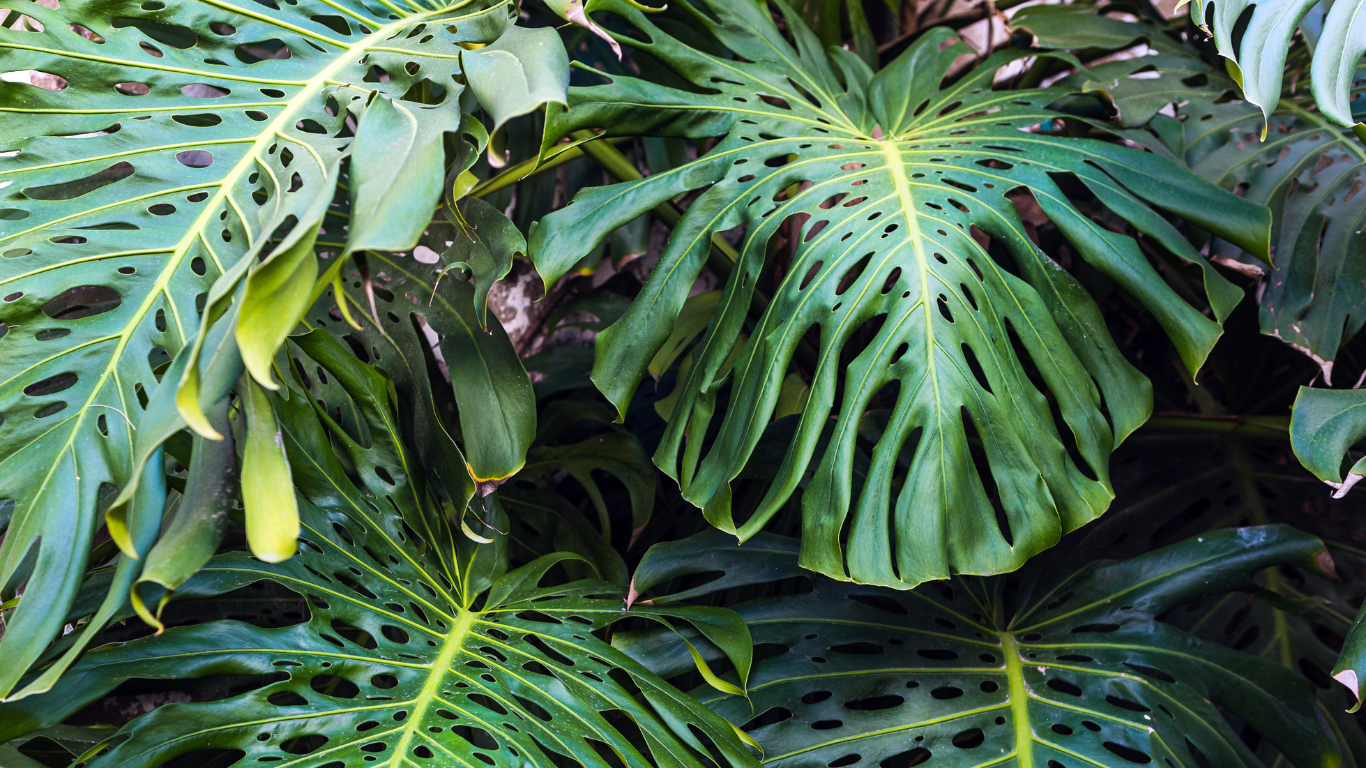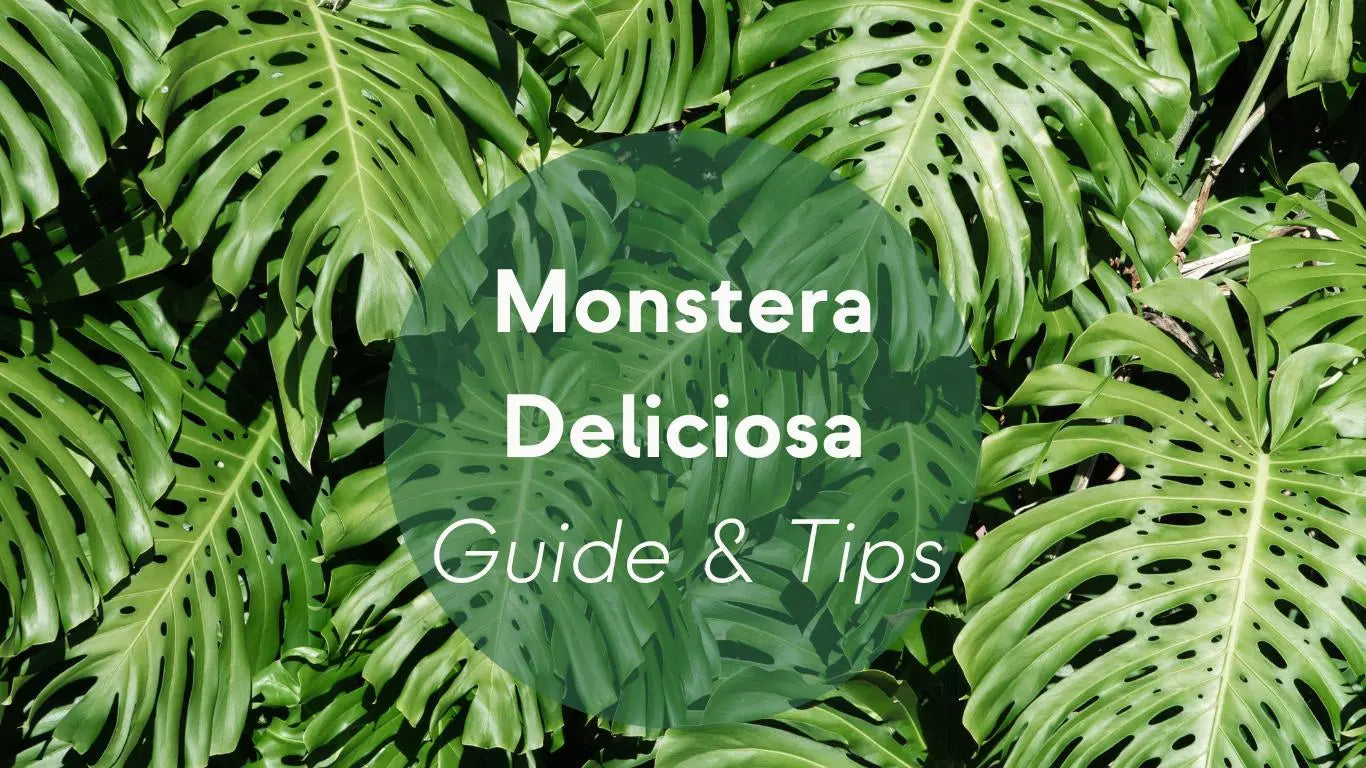
The Monstera Deliciosa is a tropical climbing plant that produces huge, fascinating leaves. These houseplants look especially nice in a hanging basket and are one of the easiest houseplants to grow.
About Monstera Plants
Native to the rainforests of Central America, the big, Monstera deliciosa plant is also known as the "split-leaf philodendron." This easy-to-grow climbing evergreen can be found in many designer spaces for its "wow" factor.
Indoors, the plant has a slower growth rate and can grow in height about 1 to 2 feet a year. Its naturally glossy large heart-shaped leaves have a characteristic split. You'll also find intricate aerial roots growing out of the soil which benefit the plant by supporting the stems that hold leaves that can grow up to 3 feet long.
Plant outdoors in the right zone at any time during the year and it will also produce tannish-cream flowers pollinated by bees and edible juicy fruit with the combined flavor of pineapple and banana. However, fruiting is not common in houseplants. This beautiful plant can be mildly toxic to pets.
|
Common Names |
Split-leaf philodendron, Swiss cheese plant, windowleaf, ceriman |
|
Botanical Name |
Monstera deliciosa |
|
Family |
Araceae |
|
Plant Type |
Climbing evergreen |
|
Mature Size |
3 ft. tall, 2-3 ft. spread |
|
Sun Exposure |
Bright indirect sunlight, partial shade |
|
Soil Type |
Peat-based potting soil, well-drained |
|
Soil pH |
Acid or neutral |
|
Bloom Time |
Mid-summer |
|
Flower Color |
Cream/tan |
|
Hardiness Zones |
10-12 (USDA) |
|
Native Area |
Central America |
|
Toxicity |
Toxic to cats and dogs |

Getting to Know Monstera Plants
Hardy in USDA Zones 10 through 12, Monstera deliciosa thrives year-round in warm, humid weather. When planting outdoors, establish it in part-shade in well-draining soil. If the soil is naturally salty in your region, move it to the patio or indoors. Apply a balanced fertilizer three or four times a year and the plant may grow 10 feet tall or more. If it's intended as a houseplant, choose a deep pot with many drainage holes.
How to Care for Monstera Plants
Basic Care for Monstera Plants
Light
This evergreen prefers bright, indirect sunlight in temperatures that remain consistently between 65 and 75 degrees Fahrenheit. Too much direct light in warmer months may burn the foliage. Still, you should bring indoor plants outside at least once a year in direct sunlight to encourage lusher growth.
When planted outdoors, the Swiss cheese plant can grow in the full shade of deep woodlands and semi-shade of light woodlands.
Soil
When established in a container, it requires peat-based potting media. Outdoors, it is suitable for light sandy, medium loamy, and heavy clay soils with acid or neutral pH. Even so, it thrives most in well-drained, moderately moist soil.
Water
Give the plant regular waterings during the growing season every one to two weeks. Water until excess drains through drainage holes. Do not put the excess water back into the plant's container because the plant has taken all the water it needs. The soil will need to dry out slightly in between waterings. Water only occasionally in fall and winter. To increase humidity indoors, mist the foliage using a spray bottle of demineralized water or rainwater.
Fertilizer
Choose a balanced liquid 20-20-20 fertilizer to feed the plant every few weeks during the growing season. Dilute 1/2 teaspoon of the fertilizer in a gallon of water. Use the diluted fertilizer in place of a regular watering. Pour the mixture into the soil until it begins to flow out of the drainage holes. Throw out the excess diluted fertilizer because the plant has taken what it needs and cannot use the extra that it drains off.

Monstera Pest and Diseases
Wiping dust or debris off leaves with a damp sponge or paper towel will keep the plant clean and avoidant of pests. However, common pests that can invade the plant include mealybugs, aphids, thrips, scale, and spider mites. If any are found on the foliage, spray the plant with a direct water stream. Leaves can also be washed with specialized insecticidal soap.
How to Propagate Monstera Plants
Monstera deliciosa can be easily propagated by stem cuttings from pruning. However, the most popular method of propagating Monstera deliciosa is air layering. Here are the steps for both methods:
To propagate with stem cuttings:
- Using a clean, sharp pruning shear, cut off a stem that includes a node (a little bump, which is where the roots will emerge), an aerial root, and at least two leaves.
- Put a dash of ground cinnamon (the usual spice you can get at the grocery store) on the mother plant where you made the cut. This will prevent any disease from entering the cut and will help the wound heal.
- Put the cutting in a glass of water. Change the water every three to five days, and if possible, use filtered water or rainwater over tap water.
- You will see a clump of roots growing in a couple of months. At that point, you can put your new plant in a pot with fresh soil and keep it moist as it establishes itself in its new home.
To propagate with air layering:
Air layering is a preferred low-risk method because you're not making a cut in the mother plant until the baby is ready to be put in a pot with its new roots. The mother plant may not look attractive for a while, but it's worth it to get a healthy new plant. For this method, you'll need floral or sphagnum moss, a plastic bag or plastic wrap, and twist ties.
- Find a stem with a couple of nodes (where the roots will grow). Or, find a leaf that is growing out of a stem and has a short aerial root below it.
- Cut a small notch about 1/3 of the stem's width, just below that root.
- Wrap a 1-inch layer of sphagnum moss around the point where the leaf joins the stem.
- Spray the moss with water to increase moisture and wrap it in plastic. Use twist ties to secure it.
- Ensure the moss can remain moist until the roots develop.
- When roots develop in a few months, you can cut (with a clean, sharp tool) the stem below the roots and establish the young plant, with its roots, in a fresh pot of soil.
- Don't forget to cover with ground cinnamon the wound created on the mother plant.

Monstera Did You Know
- In the wild, Monstera Deliciosa has incredibly rich fruit. It tastes like the combination of strawberries, passion fruit, mango, and pineapple. It is so delicious that the Monstera Deliciosa owes its name to it.
- By developing holes in its leaves, the large Monstera leaves are better suited to withstand heavy rainfall and wind as they let the elements pass through the holes.
Monstera Plant Varieties
There are several varieties and subspecies of Monsteras, all of which share similar characteristics in terms of preferred environment and looks. These are the most common ones:
- Monstera Deliciosa
- Monstera Borsigniana
- Monstera Variegata
- Monstera Adansonii
- Monstera Pinnatipartita
- Monstera Dubia
- Monstera Siltepecana
- Monstera Obliqua

Monstera Summary
Monstera plants are arguably one of the most spectacular indoor plants to grow, especially if you live in warm climates and you provide it with ample space to climb. This wonderful plant, has huge shiny leaves that can have stunning variations in color, shape, and size.
When it comes to automated plant care systems, Monstera plants are one of the ones that usually struggles with them, as they require constant but light watering, plenty of light and humidity. Only truly smart plant care systems like KORU can adapt to each plant's different needs, helping them to thrive by measuring light, temperature, humidity and soil moisture.

Share:
Rubber Tree Plant Care: Guide & Tips
Botany Labs joins Viva Con Agua in Promoting access to Clean Drinking Water for All